Thinking of buying your first dirt bike? I understand. I've been there myself, not that long ago. And I'm here to help you sort the options.
Fun, fast, and (in some cases) forgiving, dirt bikes are a machine unto themselves. Problem is, "dirt bike" as a descriptor doesn't dive deep enough. It's like calling a machete a knife. Are you planning to slash brush or butter toast? Some off-road motorcycles downright drip adrenaline, flying high over massive jumps at the motocross track, while others cheerfully trundle down an unpaved country lane, barely disturbing the wildlife. It's easy to make the wrong choice, and with the off-road segment growing rapidly in recent years, legions of relative newcomers are learning too many lessons the hard way — myself included.
So let's take a step-by-step approach to help you choose your first dirt bike.
What kind of beginner are you?
If you are choosing your first dirt bike, you might be someone who has been riding a motorcycle on the street for years and wants to try a new kind of riding, or maybe you're a person who's never ridden a motorcycle at all. In addition to training courses aimed at beginning street riders, the Motorcycle Safety Foundation also has a one-day course to introduce new riders to off-road riding. The advice below applies to both those who are new to riding and those who are just new to dirt, but if you already have riding skills on pavement, you might be comfortable with a little more motorcycle under you than a totally new beginner would.
Either way, the range of things you can do with a dirt bike is broad, from competition to quiet rides in the woods, so the first step in choosing your first dirt bike is answering the elephant-in-the-showroom question: What are you going to do with it?
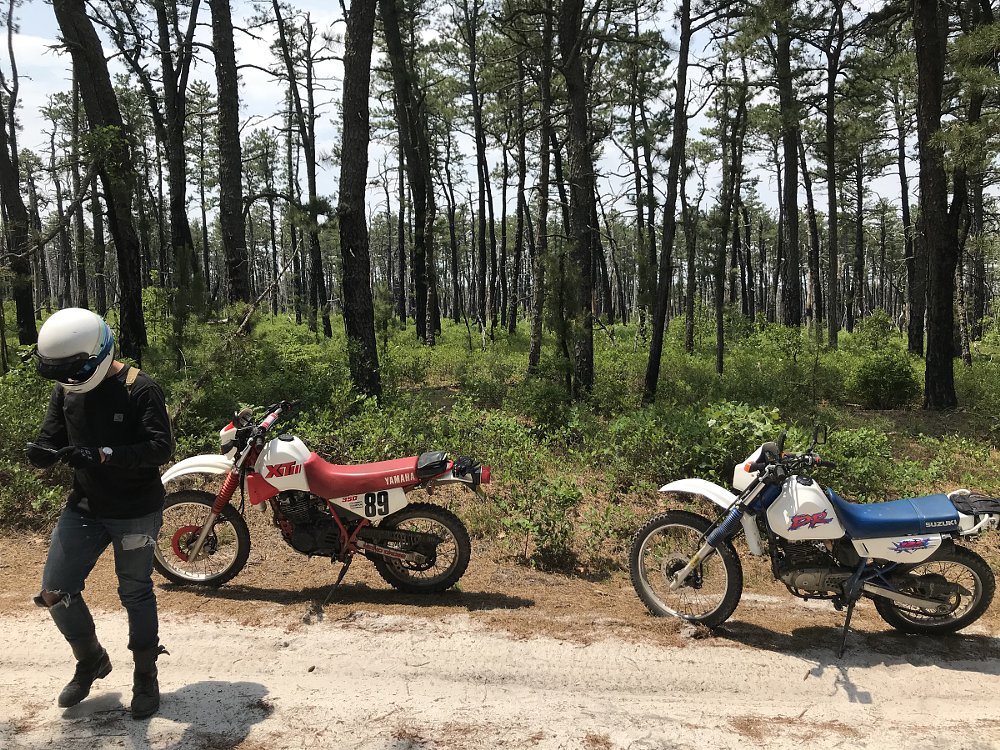
Choosing the kind of off-road motorcycle for you
Make no mistake… not all knobby tires are created equal, and neither are the bikes that roll on them. Off-road motorcycles come in three basic categories, and the one you choose will depend on how and where you plan to ride.
Dual-sport motorcycles: Street-legal dual-sport dirt bikes are the approachable and versatile choice for weekend warriors seeking overall tame trail riding. Cleaner-burning four-stroke powerplants, DOT-approved tires, lights, turn signals, mirrors, spark arrestors and a horn are there for a reason, while the whiz-bang parts of race bikes (and their corresponding price tags) are largely lacking. A dual-sport gives you the option of riding on public roads to off-road riding areas, and in some parts of the country, that license plate may be required even for some off-road riding areas. The East Coast regional off-road competition association I ride with requires bikes to be street-legal because public roads are used to transfer from one trail to the next. If you're riding in California, you also need to be aware of the red-versus-green sticker program. Riding a street-legal bike bypasses a lot of these concerns.
Off-road-only dirt bikes: Dirt bikes without license plates range from mild-mannered, low-powered fun bikes to high-powered machines built for cross-country racing. If you're riding on your own land or other private land, no problem (unless you have difficult neighbors). But if you're using public riding areas, you still need to do some due diligence about the rules of the riding area where you plan to be spending your riding time. From spark arrestors to sound standards, know before you buy.
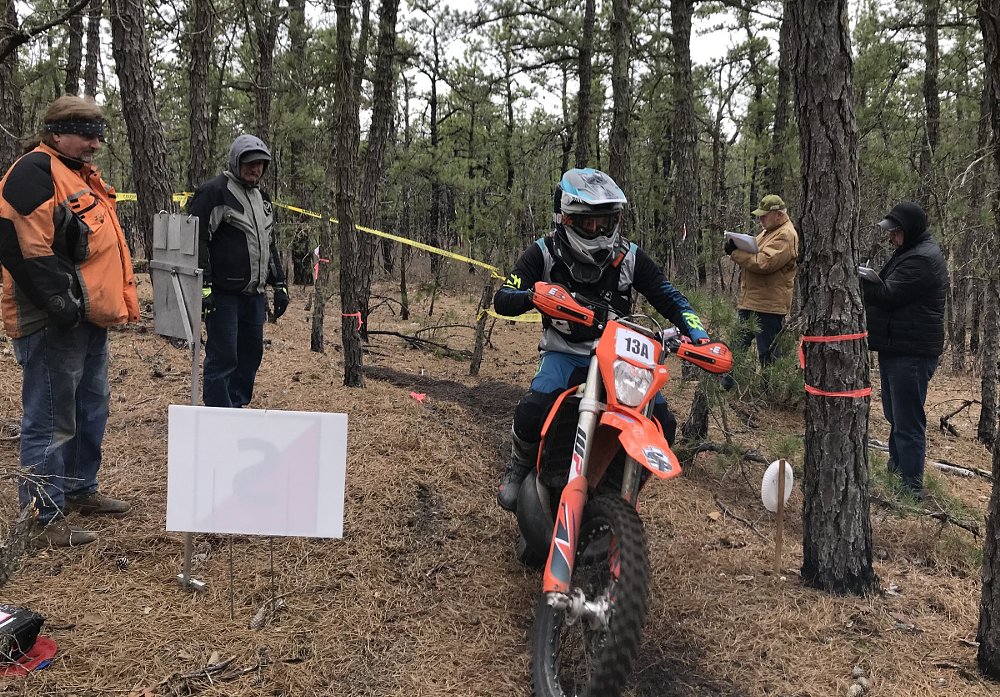
Motocrossers: Lightweight and lightning quick, motocross machines and other competition-oriented bikes are mercifully more straightforward. If your goal is to go racing at a MX track or closed-course hare scrambles, one of these competition-only bikes will let you tangle with racers and machines of equal age and ability. Even if you start at the bottom of the food chain, these competition machines will have higher spec components, especially suspensions, will make more power, will generally cost more and require more maintenance. But it's fun. As one enthusiastic Zillan wrote here on Common Tread, "Off-road racing is expensive and painful and you should definitely try it."
An addendum: Two-strokes and four-strokes: More of an issue in the past, today two-stroke dirt bikes are still around but they're definitely the road less traveled these days. If you're not up to speed, here's an explanation of the difference and why you might want one or the other. Most riders today are probably going to choose a first dirt bike with a four-stroke engine. Just don't let anyone charge you extra for a "powerband."
That about sums up your options, in terms of general categories. I don't mean to be flippant, but being able to see into the future helps. It's not uncommon to find out the riding style you thought you’d enjoy isn't what you expected and now you've got too much money tied up in one bike to justify buying another. Ask me how I know! In my case, a dual-sport let me wander around the woods for cheap, but mixing gas and burning laps on a vintage, two-stroke, 1986 Yamaha YZ250 opened doors I didn't even know I was looking for.
What size beginner dirt bike should I, a full-grown adult, buy?
Just because you can start it doesn't mean you can ride it like you stole it. You want a motorcycle with enough capability to do the things you want to do, but not one that overwhelms and brings moments of terror instead of joy. For a beginner, choosing the right dirt bike comes down to these main considerations.
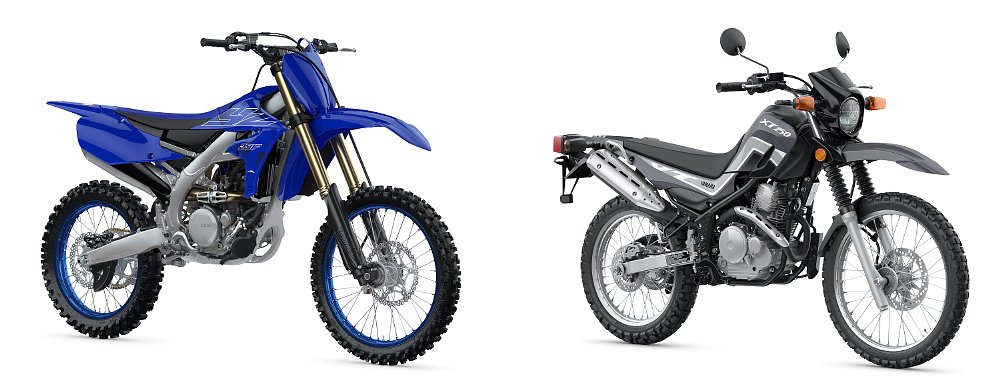
Engine displacement: It could be argued that skill level and piston circumference are plotted on the same graph. Most four-stroke 125 cc or 250 cc machines won't get you into heaps of trouble, while something like one of today's 450-class motocrossers can smack you with some serious power. It's also important to consider that the real issue is not just displacement, but power. A 250 cc bike with a mild-mannered air-cooled engine based on a past design is quite different from a highly tuned, liquid-cooled, 250 cc motocross bike. Your first clue here, after the displacement, is going to be the price and the intended use.
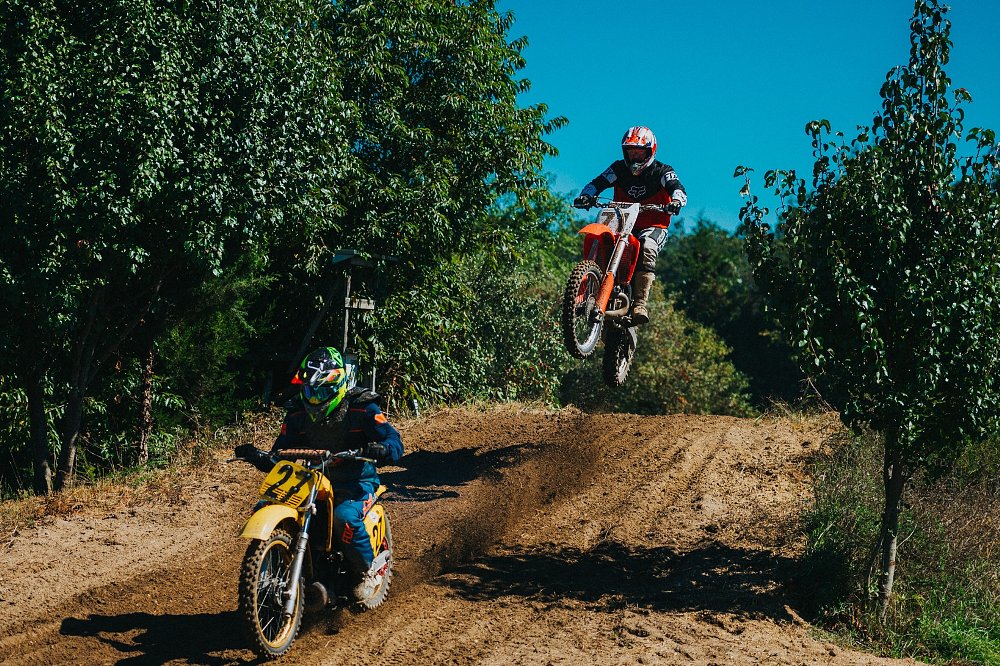
Seat height: They say there's a rear end for every seat, but you gotta climb up first. Dirt bikes are inherently tall, to provide the suspension travel needed to handle rough terrain, and being able to get your feet flat on the ground isn't the goal. But your inseam should clue you in as to whether an unladen 37-inch seat height will ever be tolerable.
I'm average height for an American male and my vintage YZ squats with a pilot aboard to about 36 inches, which has never been a dealbreaker. But that's a motocross bike, though an old one. Newer dual-sports more likely to be considered by a beginner usually have seats a little lower. For example, the Honda CRF300L puts you 34.7 inches above the ground (and Honda now has a CRF300LS "low seat" version at 32.7 inches). The approachable Yamaha XT250 also has a 32.7-inch seat height and I saw quite a few of them, and their predecessor, the XT225, at a dual-sport ride I recently did. So that's an option even if you're five feet, two inches tall.
Skill: Of course if your first dirt bike is also your first motorcycle ever, then it's clear you're starting from zero and want to choose a more approachable, manageable bike. But even if you have lots of street riding and are looking to dip a toe into the dirt, keep in mind that street and off-roading are worlds apart. Ask me how I know! Fortunately, riding like a baby deer learning to walk only lasts so long. Stick with it will and eventually you'll master the body English required to manipulate these machines and grow comfortable with the feel of ever-changing traction beneath your tires.
Experienced riders who mean well, but may not remember that clearly what it's like to be a beginner, sometimes advise new riders to buy a more powerful or capable motorcycle "so you won't outgrow it." It's a legitimate concern, but consider the downsides of buying too much or too little motorcycle. A beginner who buys a bike that's too mild and after a year of riding yearns for something more capable can always sell that first bike to another beginner and buy something new. And buying motorcycles is always fun! The beginner who buys a bike that's too powerful or too tall or too hard to handle may get discouraged or possibly even injured in a fall and lose interest altogether.
Like our "How to choose your first motorcycle" article says, you shouldn't expect your first bike to be your last bike. Instead, think of it as the first step in a journey of many new discoveries. If you find you really like riding in the dirt, you'll want to try new kinds of riding on a variety of machines. Outgrowing your first motorcycle is actually a good thing.
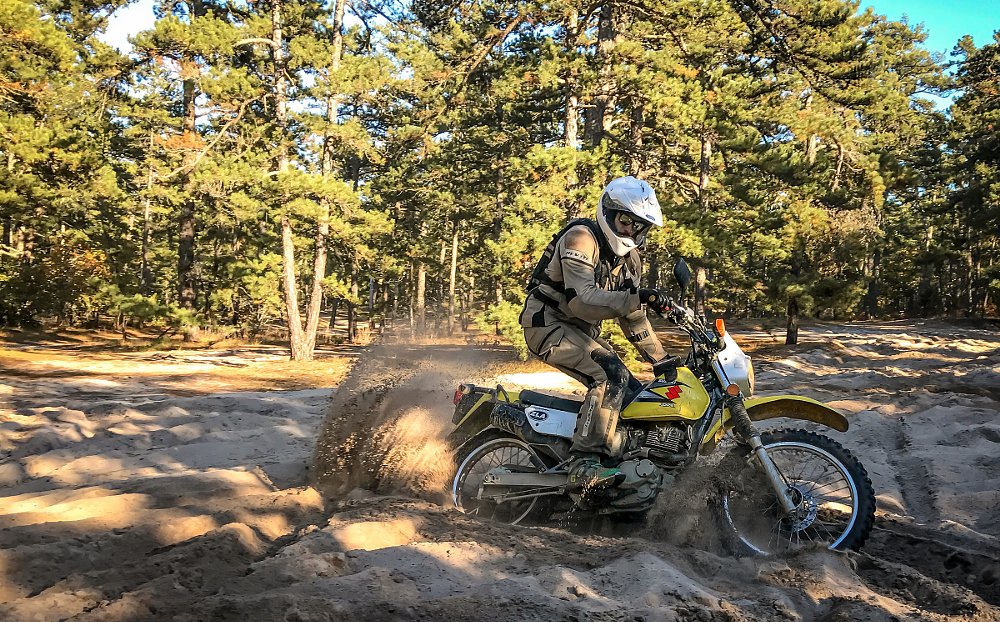
Should your first dirt bike be new or used?
There are legitimate arguments for both buying new and buying used. Rolling a new motorcycle out of the local dealership absolutely has its allure and merits. Not having to worry about how many hours are on the engine or who rounded off a bolt before you took ownership are confidence boosters. You can also start building a relationship with the parts counter and service department, if you're not going to be doing all the maintenance yourself. Historically, buying new comes with a much higher price tag. But since the pandemic, even that difference has faded as the surge in sales of dirt bikes and dual-sports has driven up prices of used motorcycles.
Still, even in these unusual times, you can shave that cash-in-hand investment by browsing for used dirt bikes that aren't clapped-out, rattle-canned time bombs. Do you have the garage space, mechanical ability, and interest to work on an older motorcycle yourself? If so, a used bike makes more sense. If you're not yet that knowledgeable, try to enlist the help of a more experienced friend and definitely check out our video and written article on how to buy a used motorcycle, our used bike checklist, and our tips on avoiding paperwork issues.
Back at the beginning of this article, I called dirt bikes "forgiving." Riding off-road means falling down, inevitably, and when you dump a dirt bike, the damage pales in comparison to the condition of a post-spill street bike. One of the arguments against buying a new street bike as your first motorcycle is the amount of damage even a mild tip-over can cause, and new riders typically have a few tip-overs, or worse, while learning. That's less of a concern with dirt bikes, which weakens the argument against buying new.
At the same time, dirt bikes are generally easier to work on that street bikes. They have single-cylinder engines that aren't shrouded by a bunch of plastic, so regular maintenance is usually easier. If you want to learn some mechanical skills while you're also learning some new riding skills, a used dirt bike can be a great way to do both.
Add up those pluses and minuses for new versus used and see what makes the most sense for your situation.
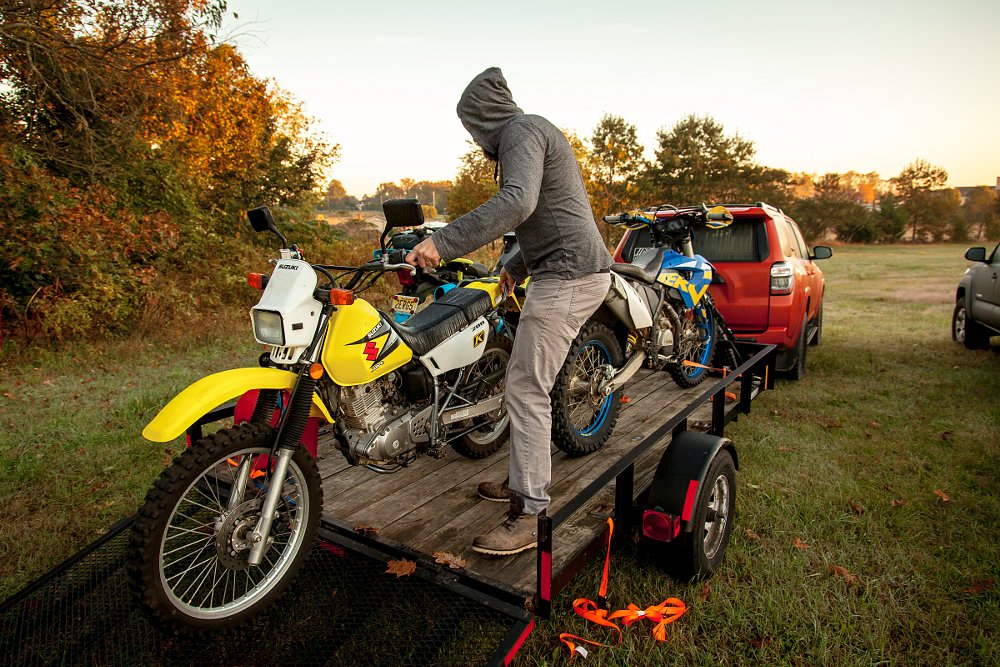
Transportation: Getting to the dirt
So you bought a bike? Great! Glad we could help. Now how are you getting it home?
If you bought a street-legal dual-sport, and your off-road riding areas are within the range you're comfortable riding your bike, then this doesn't apply to you. But if you buy an off-road-only motorcycle, are planning a week-long camping and dirt riding trip to a far-flung location, or you just want a comfortable seat for the trip home after a full day of getting whooped by Mother Earth, then vans, trucks, and trailers will be part of your dirt-riding experience.
That's another expense you may have to consider. In my case, after buying my dirt bike, I made another four-digit investment into this grand experiment and got a neat little van that also became my daily driver. If you already have a pickup truck, the only investment you may need to make is a ramp. If you have a vehicle that can tow a small trailer, that's an inexpensive transportation option (and naturally we have tips on towing and loading a motorcycle into a truck).
How I learned to stop worrying and love dirt bikes
If you've made it this far, maybe we're a bit alike. Street bikes gave you the freedom to roam, but their purview ends at the pavement and you've seen it all before. Despite a childhood on and around dirt bikes, I didn't "get" them as I got older. Two decades later, I looked back at all that '90s neon, those mean racing machines, plus my bank account balance and thought, "Hey, that looks fun."
So here it goes, my final pitch and plea to get you on a starter dirt bike: Tired of the same old schlep through the same old scenery? What once was breathtaking now only brings boredom? Then boy howdy, punching through some wooded single-track, clearing your first double, or navigating to rural points unknown are the cure you're looking for. Get ready to come home exhausted, filthy, probably smelling like gasoline and most importantly, ready to do it all again next Sunday.
















